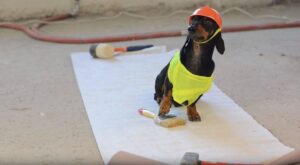Mistakes That Everyone Makes With DIY
Back when I was a little kid, my father would always have some kind of project going on. Usually, he was pretty good at whatever he was doing. He’d fix the car, build a shed, fell some of the hickory trees in the back yard. Most everything came out pretty professional at the end, but that chainsaw caught the brunt of his inexperience when he got it firmly stuck in a massive tree trunk. That chainsaw had to have been stuck in that tree for the better part of a year before he eventually got it out.
In other words, as my dad quickly learned, it would behoove you to know your limits. If you’re not trained or experienced in performing home repairs, then you’re going to somewhat struggle through a lack of knowledge, poorly applied technique and a general lack of experience. What a handyman has successfully done 100 times over, you, the homeowner, may be tackling for the first time.
Here are some of the mistakes that almost everyone makes when trying DIY.
Biting Off More Than You Can Chew
Biting off more than you can chew alludes to attempting a task that is going to certainly be beyond you. Don’t take it personally, but if you think that you’re going to singlehandedly re-wire the entire house when you don’t know what the little wavy line on a multimeter means, you’re probably mistaken. Also, if you’re planning on putting in a new boiler and redoing all the water pipes in the home to create a brand-new plumbing system when you’ve never soldered a pipe before, then we wish you the best of luck.
But in all actuality, this problem extends across all forms of DIY and home repair situations. Sometimes it’s because it is difficult due to either not understanding the full scope of the problem or having never tackled this kind of thing before; it’s much larger than you believed when you got started. You may grind to a halt and need to call in a professional to rescue you from a bad home repair situation.

Making a Start on Multiple Projects
You might be a dabbler. If you tend to make big plans but never finish anything (you know if that’s you), then DIY is a dangerous pursuit. We’d suggest staying away from it. Why? Because you will end up starting multiple projects with gusto, but then bounce between each project as you hit a snag. The snag might be something turning out to be harder than you expected, or more time consuming. You then flip between projects.
What’s the result of all this? You don’t finish anything. Maybe you know friends like this who’ve done a makeover of their entire home and it’s three years later and his wife is being driven up the wall with all the half-finished projects? He doesn’t get the problem and she’s wanting a divorce. Well, almost.
To avoid this happening, pick one project, plan it well and complete it on time. Then move onto the next project. Do not start more than one active project at one time. It’s a recipe for never finishing. Don’t say we didn’t warn you.
Major Door Repairs or Putting in a New Door
You’ll find that when it comes to door repairs and installations, it’s trickier than it looks. It also requires more than one person to do it right. After all, can you position a door inside the doorframe and hold it perfectly steady while screwing the hinges in? Okay, so you can use an electric powered drill to make it go faster, but even so.

There are many a homeowner who have measured poorly or bought a new door at first sight and hoped it would fit… Don’t be that person. We implore you!
When repairing a door, not the door frame, you’ll find that it’s at least a two-person job. When repairing or replacing a door, it’s not just the people needed for the task, but there are so many things that can go wrong where true expertise is required. Otherwise, you end up with a door that is miles away (okay, inches away) from the door frame. Not only is that a heating and draft issue, but it is problematic from a security standpoint as it’s too easy to lever the door open.
Picking the Cheapest Contractor
It’s easy to be on a tight budget or look for a bargain when you hire someone to get a home repair or maintenance job done. Don’t. We say this sincerely because what usually happens is you end up having to pay more than twice over for the job – first, for the ham-fisted attempt, and second, both to remove what was done (hopefully they didn’t mess things up too badly) and then to put in a proper solution. Also, it takes more than twice the time, twice the inconvenience, and more time off work to resolve the issue. Then you’ll regret not going with a better contractor the first time around.
The thing with better contractors is, they’re busy because homeowners stick with ones they can trust with multiple jobs over the years. The cheap ones have usually barely been in business six months and that’s why they’re cheap. If they were any good and have referrals because of excellent work, they wouldn’t charge so little for their professional services.
It comes back to the value of your home, and you don’t want to mess with that.
Not Budgeting
Depending on how large a job you’re taking on, you have to expect there to be problems along the way. These problems inevitably lead to budget overruns. For instance, you plan to put down a new carpet and cost out the price of the carpet and fittings. However, when pulling up the carpet, you discover a problem with rotting floorboards. Some will need to be replaced or lifted to check whether the building’s foundations have been affected. This is going to cost more and cause delays to completion too.

Take any budget that you create for a DIY project and double check it. If you have a friend who’s completed a similar home project, check with them to see how much it cost them. See if they’re willing to look over your budget to critique it. And after all that, make sure to add a 20 percent margin for Murphy’s Law – what can go wrong, will go wrong. That’s not so much for getting quotes incorrect for a pot of paint, but more to cover the unexpected things that crop up when fixing one thing and something else breaks or shows it needs work too.
Buying Materials Before Your Plans Are Set
One expensive mistake is to buy the materials you think you’ll need in advance only to discover that you bought the wrong kind. For instance, you might buy new flooring but then find that you needed more materials than planned to handle corners. Then the store is sold out of the flooring pattern, so you’re unable to buy more of it for several weeks. Or ever.
Take your time to plan and check everything thoroughly before you make any significant purchase. This avoids wasting money and getting yourself into a real bind.
Handling DIY projects yourself is fraught with difficulty. Most times you’re attempting to tackle something where you’ve only read how to do it from a book or watched a couple of YouTube videos. Don’t be afraid to get professional assistance when you feel out of your depth.